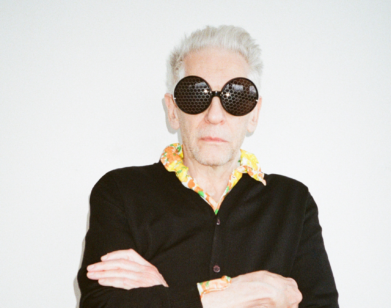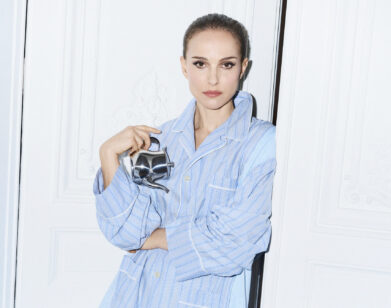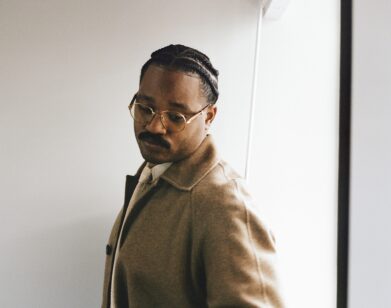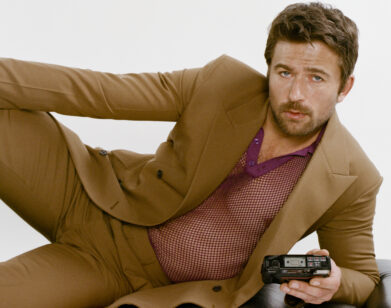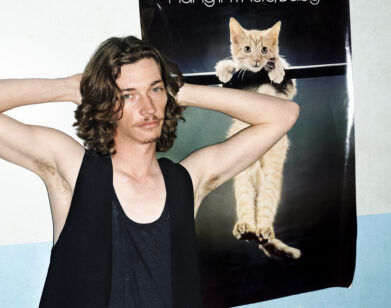The Story of Genesis
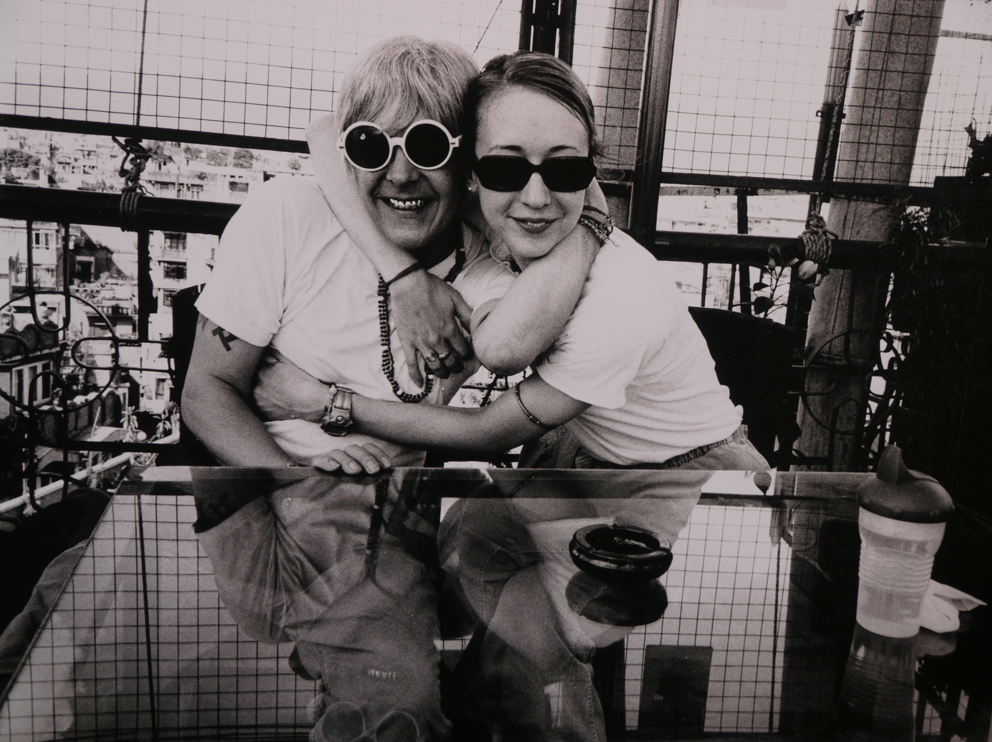
ABOVE: GENESIS AND LADY JAYE BREYER P-ORRIDGE
The ballad isn’t the first musical form that comes to mind when you think of Genesis Breyer P-Orridge. As a member of the pioneering group Throbbing Gristle, she redefined the use of noise in a musical setting, creating the genre of industrial music in the process. The Ballad of Genesis and Lady Jaye is more than a rock-doc, or portrait of a veteran artist. By focusing on the deeply committed relationship between Genesis and her wife, Lady Jaye—the two embarked on a years-long project to become a single entity, going so far as to get plastic surgery to more closely resemble one another—the film becomes a document of a loving union that expands the boundaries of art and life.
Interview spoke with Genesis Breyer P-Orridge and director Marie Losier about the first time they met, the love story at the heart of the film, and making art out of life. [Note: P-Orridge uses the first-person plural “we” to refer to herself, as well as to herself and Lady Jaye.]
CRAIG HUBERT: Marie, you are very much a part of this film with your camera. There is no sense that you are trying to be an invisible presence, or a fly on the wall.
GENESIS BREYER P-ORRIDGE: She’s even in the shot sometimes, dancing on the bed…
MARIE LOSIER: [laughs]
HUBERT: So how did you two meet initially?
P-ORRIDGE: [Looking at Marie] This is your story.
LOSIER: I didn’t know anything about Genesis or Lady Jaye. I didn’t know the music, because I didn’t grow up in the United States. It wasn’t on my radar. I went to see Alan Vega from Suicide, and the third part of the concert was Genesis with Thee Majesty. It was basically, when I arrived, Gen reading poetry. I’m very attached to voices, and it really moved me. I left the concert very touched. The next day I went to pick up a friend at a gallery opening. There were so many people that I walked on the foot on someone—that someone turned around, I excused myself, and it was Genesis. I told her, very simply, that I saw her the day before and it moved me. She was so generous and open and happy to hear it. It was a very fast encounter. I told her I made films and she gave me her card. I was invited to their home very quickly. Gen opened the door, sat me in the basement where you see all the archives [in the film] and Jaye came down with tea.
P-ORRIDGE: What Marie didn’t know was that Jaye, literally a week or so before that, had been saying that we should document this project, now that we’ve decided to push the envelope and go for it. We can’t do it ourselves—we’re the subjects. Jaye was thinking of it in terms of Andy Warhol’s Factory, having someone around all the time that just films and photographs. Not to make a film, but just to document everything so we could look at it later. We bumped into Marie and, of course, we tend to assume that, as Burroughs said, “How random is random?” The fact that she said she made films tickled our imagination. We never saw her films before we decided to work with Marie. Jaye just said, suddenly, after about five minutes, “She’s the one.” That was it. We tend to trust Jaye’s intuition. Two weeks later we went on tour with Psychic TV around Europe. We said to Marie, “You want to start next week?”
HUBERT: Is that the tour footage that ended up in the film?
LOSIER: Yeah, what you see at the end, edited all down. It was a long ten days—a wonderful ten days where I learned what it means to be in a rock band. [laughs]
P-ORRIDGE: How little good food you get. And within a couple of days we all forgot she was filming, which was the idea. So it just kept going. Six years later, she was still filming.
LOSIER: With Gen and Jaye, without me knowing, and only at the end, I realized it was the most complete match between how I make films and edit and the subject’s work—the collage, cut-ups, rhythm, and music.
HUBERT: Were there moments you knew you wanted to capture on film, or was it more of an organic, spending time with one another, and the camera is just always around?
P-ORRIDGE: Sometimes we’d say, “Oh, we’re moving out of the house.” And she would say, “I need to come and film!” But that didn’t even get used. Sometimes we’d just mention something was happening and she would come and film it. Nobody knew what the film would be. Marie did talking head interviews with quite a lot of people she ended up not using, either.
HUBERT: Was there an initial plan to take a more traditional approach?
LOSIER: I never plan any of my films. There’s no script. It’s really about where it takes me. There’s always the setup of these tableaux vivants that often for me are like chapters in a book, which gives it a rhythm. That’s how it’s constructed, but it’s a constant collaboration. It slowly builds up. The love story was what was the most important to me. Building this love story was explaining where these characters came from, at least visually.
P-ORRIDGE: There was a section with the cosmetic surgeon that was recreated. He got into it, exaggerating the markings on the face. He got into the feel of the film.
HUBERT: Genesis, since the love story was mentioned—and the film really is, above all else, a love story—can you talk a little about how you met Jaye?
P-ORRIDGE: We were going through a really unpleasant divorce. We were living in Northern California, and had been thrown out of Britain for seven years, as it turned out. So we were living as a single parent with two young daughters, ten and eight years old, which was stressful. Once in a while, we’d get a weekend where we could be alone and have a big blowout, just go crazy in New York. When in New York, we’d stay with our friend Terrence Sellers, who we met through her writing. She wrote a book called The Correct Sadist, about her work in a dungeon. It’s really great. One particular weekend we’d been up for nearly three days on Ecstasy, really good pharmaceutical Ecstasy, and we finally crashed. Terrence was already asleep in her small apartment off the dungeon, and we didn’t want to wake her up so went on the dungeon, and lay on the floor and put a white sheet over and went to sleep. When we woke up, we must have heard voices. The door wasn’t closed, we’d left it open. We noticed this amazingly beautiful young woman walk past. She was wearing all ’60s clothing—she looked like Brian Jones, who is one of my long-term fetish heroes. We could tell it was all authentic ’60s stuff. She has style! Then we realized she must be one of the dominatrices because she was casually walking back and forth, with a cigarette in her hand to accentuate what she was saying, and gradually getting undressed. [laughs] We couldn’t hear anything. Then she got dressed in all fetish clothing. We thought, “Wow! She’s amazing!” Then it was this really strange moment where there was almost a split in my consciousness. One part of me was still aware of being Genesis, and the other part of me was speaking out loud, saying, “Dear Universe, if we can be with that woman for the rest of our life, that’s all we want.” We’re thinking, why are we saying that out loud? What the hell is going on? It turned out, what was happening to her, there was someone we couldn’t see who was saying to Jaye, on the other side, “Don’t go in there. It’s a lunatic, this weird artist from England.”
LOSIER: [laughs]
P-ORRIDGE: Jaye’s thinking, of course, “Wow, I should go in.” She took me to a slave auction that night in this club called Paddles. She was dressed in skintight leather, wearing five-inch heels, and I just thought, “This is an amazing woman.” We became obsessed with each other — instant love. She was just getting over a relationship, and we said, “We’re a mess, we can’t jump into a new relationship.” We became loving friends, and for a year, we were just…
LOSIER: Courting.
P-ORRIDGE: Yes, courting. Jaye and I used to sleep in the same bed together at her place in the East Village. Again, we suddenly said, “Will you marry me?” We’re thinking, “We just got out of a marriage, what the fuck is going on?” She said, “People keep saying that to me, and nobody ever buys me a ring—if you buy me a ring, yes,” being sarcastic and funny. But we did. We went back to California, did some record deals, and bought her a diamond ring. She was impressed, because she knew I was broke. So we got engaged. Then we became full-on lovers. We were together pretty much from the first day.
HUBERT: I thought we could talk a little about the pandrogeny project and when it began.
P-ORRIDGE: It started the first day. The first night we met she took me to her apartment and dressed me in her clothes. We learned everything to do with style from her. It just grew from that. First we dressed alike and then we got to the point where we wanted to totally merge, an infinite mutual orgasm, if you like. Then we started to think about why we were so attracted to doing that and it became a project. Night after night, day after day, we developed an explanation of why we were so drawn to take it that far.
HUBERT: There is so much tenderness in the film, between the subjects and between the filmmaker and the subjects. When did you realize this is where the film was taking you?
LOSIER: The tenderness was there from the beginning. In terms of the love story becoming more and more the essence of the film, that happened about three or four years into the film. When Jaye passed away, it became about focusing more on what was missing in terms of Jaye. She was someone [who] wanted to the film to happen but also escaped the camera. Jaye was a mysterious floating butterfly, wanting things and then flying away from them. She’s there in a very deep way. The editing took eight months of figuring out—with such abstract, three-minute rolls of film, how I could create a story? I never made a feature before. How could I make a short a feature?
HUBERT: Genesis, the films shows the wonderful archive you kept over the years, and you talk about how you wanted that project documented. So I assume it wasn’t difficult to let Marie in and dig through your history.
P-ORRIDGE: Even as a teenager we got interested in the Beats, Dada, and Surrealism, and so on. What drew us to those was that their lives were their art. It wasn’t something they did separately. Reading biographies of artists of that kind was what was fascinating to me, more than the stuff they made. We became convinced that life and art is really the same thing.
THE BALLAD OF GENESIS AND LADY JAYE IS PLAYING NOW AT THE CHELSEA CLEARVIEW.

